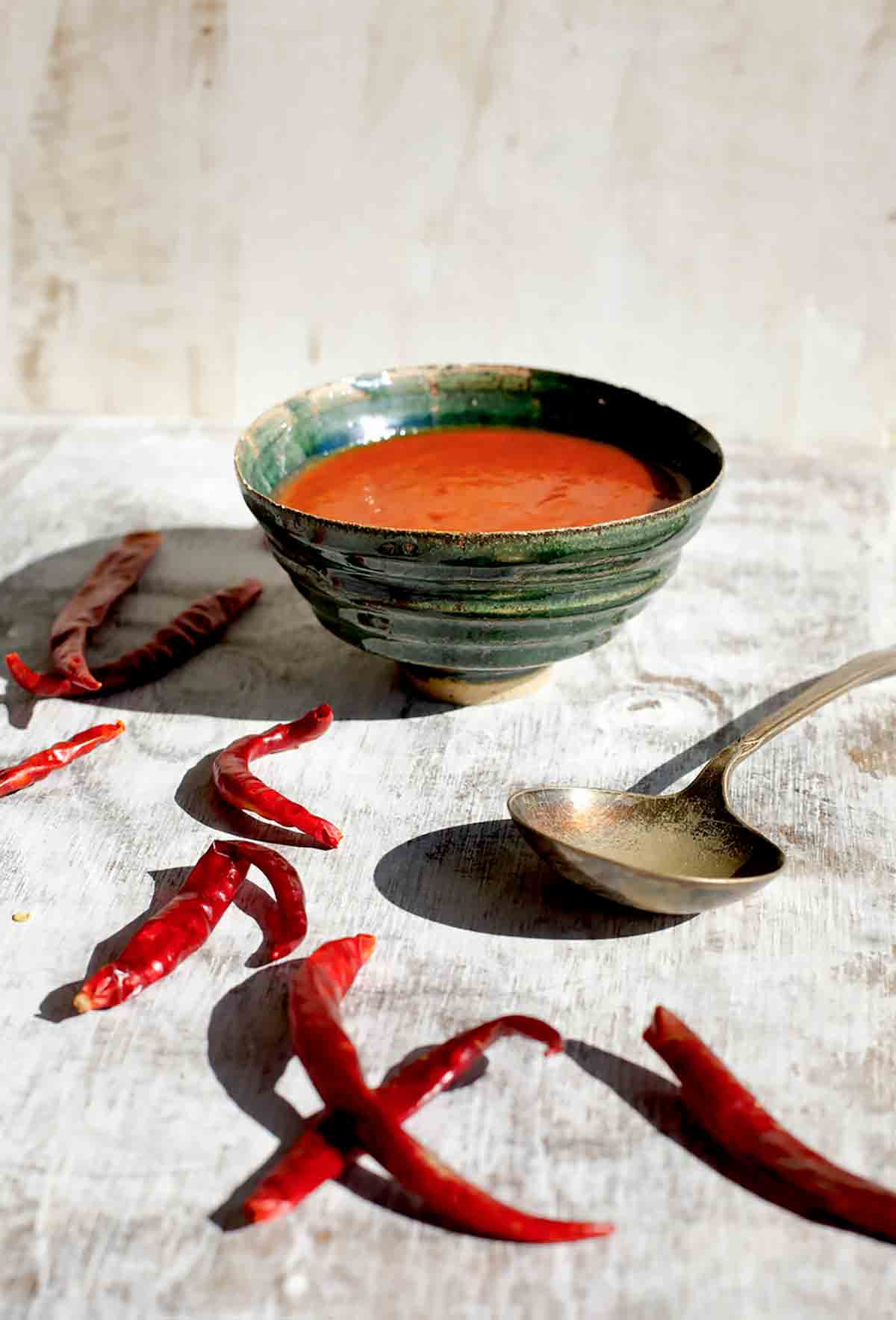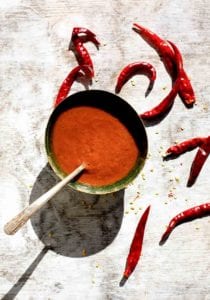
The torrid piri-piri pepper, known as peri-peri in Africa, has been a staple of the Portuguese table since the Age of Discovery beginning in the 14th century.
After Columbus brought the fiery fruit back to the continent from the New World in 1493, it was the Portuguese who carried it throughout the globe. In fact, the chili, including relatives of the African piri-piri peppers, has become so ubiquitous, it’s put to use in more than one-quarters of the world’s cuisines.
This sauce, found everywhere in Portugal and several of its former colonies, specifically Angola and Mozambique–is a must-slather on any kind of poultry, smoked spare ribs, and even grilled shrimp.–David Leite
LC Stepping In For Piri-Piri Peppers Note
Uh, the only trick is, you won’t find fresh piri-piri hot peppers stateside. Stepping in for piri-piri peppers are Thai bird (top two photos), red jalapeño, santaka, arbol, cayenne, or Tabasco, depending on availability as well as personal heat preference and tolerance. You can find dried piri-piri peppers. They pack a wallop, so experiment with the amounts so that you get the sauce you deserve.
For those concerned about the health risks of allowing raw garlic to steep in olive oil, Shirley O. Corriher, food scientist and author of Cookwise: The Hows and Whys of Successful Cooking, says that due to the sauce’s high acidity, there’s no problem. In fact, she added: “I’d be tempted to eat it myself.”


Portuguese Piri-Piri Hot Sauce
Ingredients
- 4 to 8 fresh hot chilis, depending on the heat (see LC Note above)
- 2 garlic cloves, minced
- Juice of 1 lemon
- Pinch of salt
- 1/2 to 1 cup extra-virgin olive oil, depending on how thin you want it
Instructions
- Coarsely chop the peppers and discard stems.
- Place the chilis and their seeds, the garlic, lemon juice, salt, and as much of the oil as you wish in a food processor fitted with a metal blade and purée. Pour the mixture into a small glass jar and let steep for several days in the fridge.
- You can strain the mixture and return it to jar, but I like mine with a bit of texture. Sauce will keep in the refrigerator for 1 month.

Nutrition
Nutrition information is automatically calculated, so should only be used as an approximation.
Recipe Testers’ Reviews
I received Peri Peri sauce from Africa years ago, and I rationed it like precious gold. It eventually made its way into supermarket shelves, and I was so excited to use it with abandon. I was really excited to try this recipe to see how it compares to what I’ve had in the past. I used a combination of jalapenos and habaneros, so the color was considerably more green than the picture.It had a great warmth to it on the front of the tongue and it lingered in the throat for a while. It also had a very pleasant acid level. I wanted a bit more garlic and salt, but that may come through more as it sits. I’m now just dreaming of all the meats and vegetables I’m going to drizzle this all over.I used it on cauliflower fried rice, it was fantastic.”
This spicy sauce was simple to make and can be used in a number of different ways. I used it as a marinade for a boneless turkey breast that I then baked, but it would also be great on a charred grilled chicken, or even spooned over anything needing some heat. I used 8 fresh red chilies (the variety that looks like a jalapeno but is red instead of green), 2 large garlic cloves, 2 tablespoons of fresh lemon juice, and the full 1 cup of olive oil. (Because I was wanting to have a substantial amount of sauce to marinate the entire turkey breast, I wanted a lot of sauce) I actually added in 1 1/2 teaspoons of salt here instead of a pinch Again, because this was my marinade for an entire turkey breast I didn’t want it to be lacking in flavor.
After I processed the sauce in the food processor, I let it sit in the fridge for 24 hours; I did not strain the mixture. This recipe (with the 1 cup of oil added into it) made about 2 cups of sauce. One suggestion when prepping the sauce…don’t forget to wear disposable gloves chopping the hot peppers!
Hot sauce without the vinegar with a nice after taste. For my first recipe review the simplicity worked well with only 20 minutes of hands-on time and 42 hours of steeping.I had to do some on-line research about Piri Piri sauce since my usual experience is only with Frank’s hot sauce and Buffalo Wings. I can see substituting this for Tabasco in my cooking. I will be experimenting not only with the thickened sauce but the opaque liquid that separated during refrigeration on my next batch of wings.I used 7 red Serrano peppers (102g) with 4oz of EVOO. I was able to squeeze 2Tbl of lemon juice and had 6oz of finished product before steeping. I wore gloves while prepping the peppers.
Can I start by saying “woot woot!”? January is the month I go digging into the back of my fridge and pull out a six month old packed litre jar of fermented bird’s eye chilies (my home grown piri-piri chilies) to make my fermented piri-piri sauce. Alas, there is no jar in my fridge. Last year’s crop was so meager that I just froze the chillies for individual use.
Sure, I have other recipes. I’m the girl that carries piri-piri in my purse just I case I run into food that needs rescuing.. I’m also the girl that takes an oversized lunch bag to work that accommodates various condiments including piri-piri. Never underestimate the power of a great hot sauce as a “pick me up” during a stressful day. It’s also fulfilling to be able to share one’s piri-piri with the more adventurous colleagues. Yes, I’ll share my special sauce!
When I saw this recipe, I wasn’t immediately convinced that this would be a great hot sauce. It included olive oil and only used 4 to 8 chilies. I thawed 8 of my bird’s eye chilies on paper towel so as to absorb the extra moisture. Five minutes later, I was a convert! I used my blender instead of the food processor as I have a jar just for sauces (of course I do!).
150 ml of olive oil seemed to get me the right consistency. It also emulsified the sauce so that the end result was a creamy, pleasantly hot, with a hint of lemon garlic flavour.
Straining was never a consideration. The tiny flecks of chilies just added dimension and interest to the sauce.
My first uses were little dabs in espresso spoons to confirm the sauce deserved a piri-piri title.. (wink).. I also generously doused chicken thighs in this sauce, smeared it on toasted sandwich bread, used it as a bed for smoked mackerel, and made a second batch for a couple of gifts. On day 5 of refrigeration, this piri-piri sauce remained emulsified in a soft congealed state. 5 minutes at room temperature and a quick shake of the jar brought the sauce back to free flowing and uniformly emulsified. The fact that it keeps in the refrigerator for a month means little to me as it will never last that long. Muah!













Yes, Nathan, I have been doing research on sauces (chilli sauces in particular) recently and came across Sriracha. As far as I know it is quite hot, is it not? Although I never tasted it myself.
Renee, Sofia, David thanks to you guys, very kind of you to welcome me. It’s great to be here and apologies for certain words I failed to add, as you might have spotted, for some reasons did not show as I submitted the comment.
Let me say that as much as I restlessly am trying to make peri peri sauce, yours is simple. The beautiful aroma that I got after I prepared chicken (marinaded with peri peri sauce) in my health fryer was pure gratification and sublime mouth-watering food. I am honoured to be welcomed by you all and for sure all you undoubtedly are very generous to share your stories and experiences. Tasteful! Palatable! obrigado!!!!
Our pleasure, Muhammad.
I have to say this, that in making peri-peri sauce, I also stumbled on a great Sriracha sauce method. Fermented sauce, with the great Asian flavors of Sriracha sauce you buy in the store.
Nathan, and what’s that method? We have a Sriracha sauce recipe on the site. Did you see it?